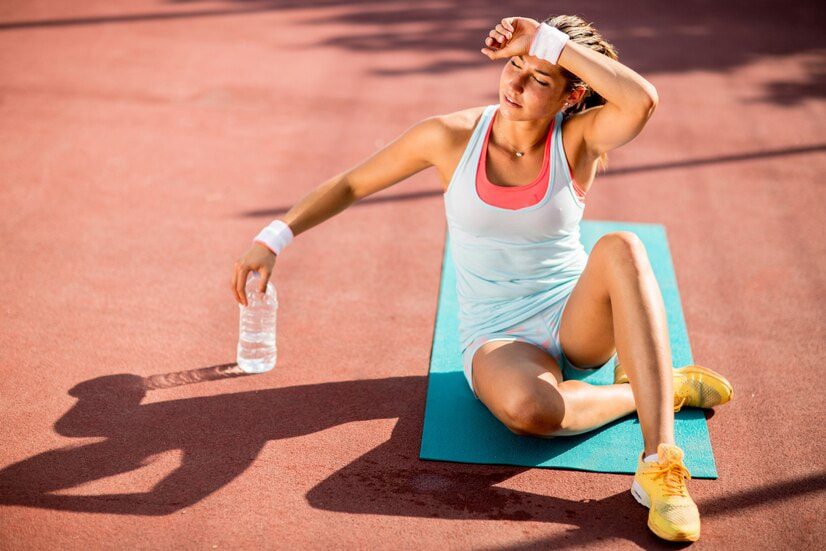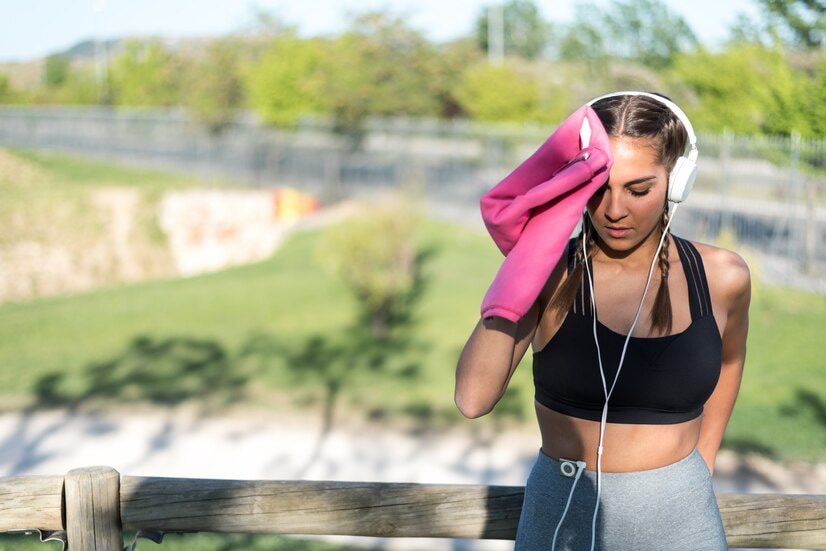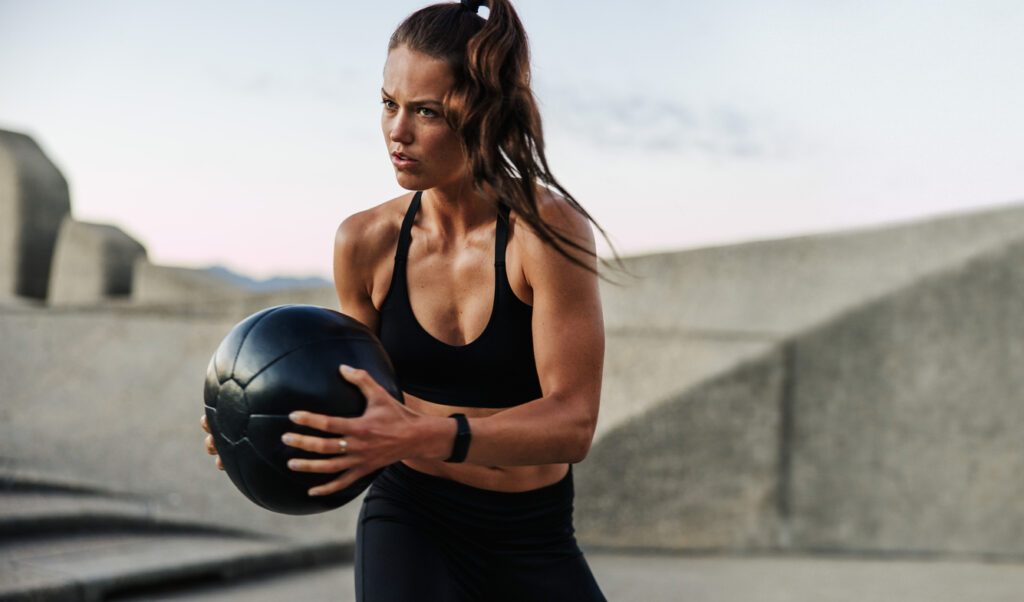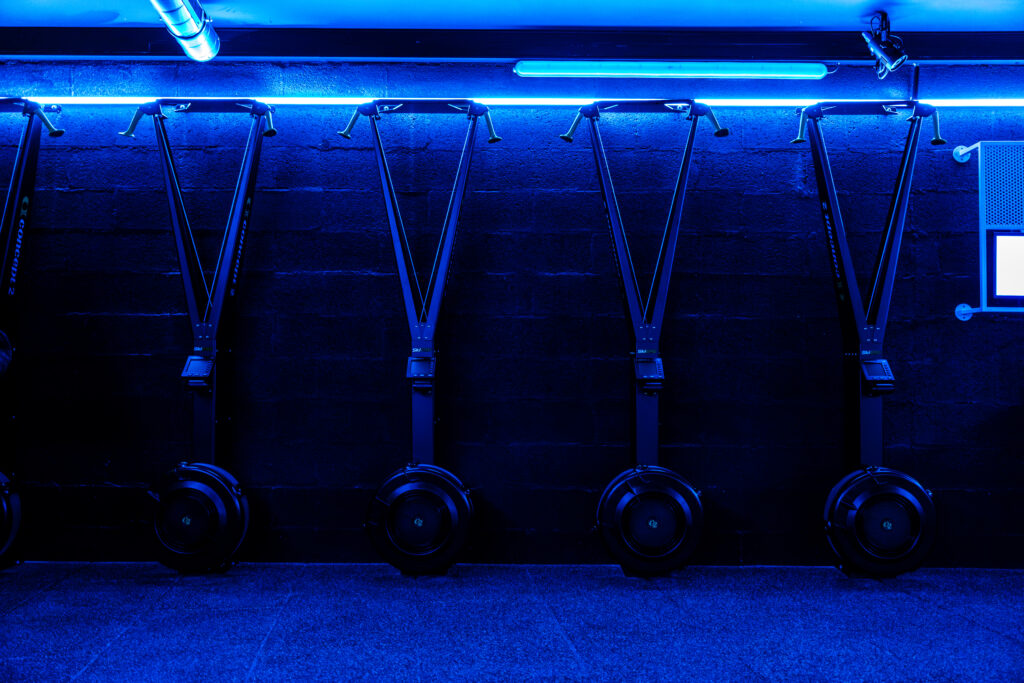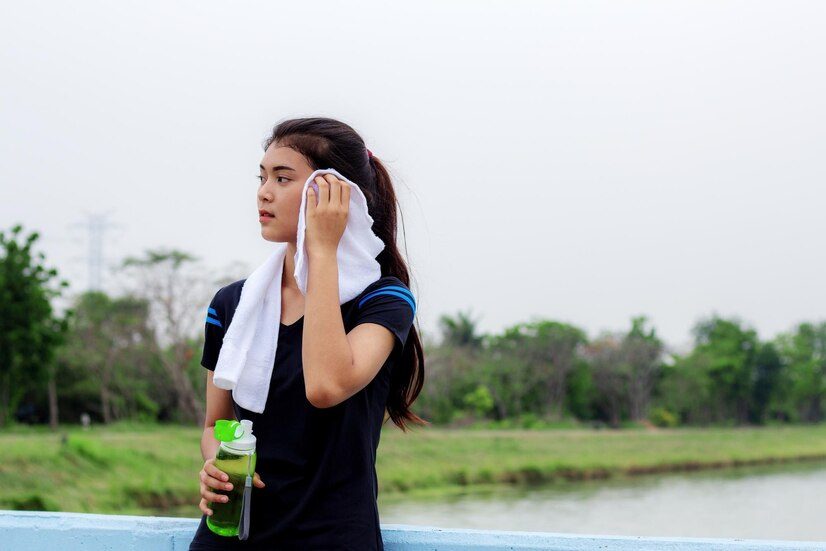
Summary
Welcome / Welcome / Tips for getting started / The benefits of sweating during sport: for better sports practice
The benefits of sweating during sport: for better sports practice
Wondering why you sweat so much during your sports sessions? Sweating, much more than just a sign of effort, is an essential mechanism for your body. It regulates temperature, improves performance and promotes well-being.
Introduction
In this article, discover how to take full advantage of sweating to boost your workout. What are the real benefits of sweat? How can you optimize this natural process? This article is for you.
When we think of sweating during sport, the image that often springs to mind is one of intense effort, sweat pouring down our necks and a feeling of discomfort linked to discomfort. Yet far from being a mere inconvenience, sweating is an essential mechanism for the human body, especially during physical activity. Although it is often perceived negatively, it plays a crucial role in regulating body temperature and maintaining sporting performance. In this introduction, we discover why perspiration is a real ally, much more than just a natural phenomenon that can sometimes be embarrassing.
What is perspiration and its role in the body?
Sweating is a natural physiological process by which the body excretes water, primarily in the form of sweat, through the sweat glands. This mechanism, although often associated with heat or exercise, is actually a complex response of the body to maintain its internal balance, called homeostasis.
When you engage in physical activity, your body generates heat. To prevent overheating, it triggers the production of sweat. This sweat, composed mainly of water and minerals, evaporates on the surface of the skin, which helps cool the body. It is this evaporation process that is the key to thermal regulation during exercise.
Misconceptions about sweating in sport
One of the most common myths is that sweating equals weight loss. In reality, sweat loss is mostly water loss, not fat loss. This weight loss is therefore temporary and will be offset as soon as you rehydrate your body.
Another persistent myth is the idea that sweating is an effective way to eliminate toxins. While sweat does indeed contain trace amounts of some substances, the majority of toxins are eliminated primarily through the liver and kidneys. Sweat plays a minimal role in this process.
In truth, sweating is above all a sophisticated thermal regulation system. It helps maintain a stable body temperature, essential to avoid the risk of overheating, which could harm your performance and put your health at risk.
The essential functions of perspiration during sport
Sweating, often underestimated, plays a vital role for all sportspeople, whether amateur or professional. In fact, it's not just a simple sign of the effort made; it's a key mechanism for maintaining the body's equilibrium during physical activity. Let's take a look at its essential functions.
Regulation of body temperature
During physical effort, your body produces heat. If this heat is not dissipated, the body temperature can rise dangerously. This is where perspiration comes in. The process is simple: when you sweat, water evaporates from your skin, taking heat with it. It's this natural cooling that keeps your internal temperature within a safe zone, ensuring optimum performance.
For this thermoregulation process to be effective, the evaporation of sweat is essential. If sweat remains on the skin without evaporating, for example in conditions of high humidity, the body temperature could continue to rise, increasing the risk of heat stroke. So evaporation isn't just a comfort; it's essential for safe and effective training.
Toxin elimination: myth and reality
Contrary to popular belief, sweating eliminates only a tiny quantity of toxins. The substances actually eliminated by sweat are mainly electrolytes, such as sodium and potassium, as well as traces of heavy metals and metabolic degradation products. However, this is only a small part of the body's overall detoxification process.
The kidneys and liver are the true champions of toxin elimination. Sweat, although it partly participates in this process, is only a secondary player. It can nevertheless help to expel certain excess substances, but it does not replace the main role of other organs. For a healthy body, it is essential to support the work of the kidneys and liver with good hydration and a balanced diet.
Improved blood circulation
When you sweat, your blood vessels dilate to allow better blood flow to the skin, where heat can be released. This process not only improves thermal regulation, but also contributes to better blood circulation. This vascular dilation allows for increased oxygen and nutrient delivery to the muscles, optimizing their function and endurance.
Sweating, by promoting circulation, helps transport oxygen and nutrients more efficiently to active muscles. This results in improved performance and better recovery after exercise. In addition, good circulation helps eliminate metabolic waste more quickly, reducing the risk of post-workout pain and soreness.
Impact of sweating on athletic performance
Sweating is much more than just a natural phenomenon, it has a direct impact on sporting performance. It acts as an essential mechanism which, when properly managed, can optimise your physical capabilities and promote better recovery. Let's explore how sweat influences your performance on the pitch.
Optimising endurance
Endurance is the ability to sustain prolonged effort without flagging. For athletes, perspiration plays a crucial role in this. Good thermal regulation via sweat helps to maintain a stable body temperature, preventing overheating. This means that your body can continue to function efficiently for a longer period, allowing you to push yourself to your limits. Insufficient sweating, on the other hand, can lead to a rapid rise in body temperature, limiting your ability to continue exerting yourself.
Improved muscle recovery
After intense exercise, your body accumulates metabolic waste, such as lactic acid, which can cause pain and slow recovery. Sweating helps to eliminate these waste products by helping to transport them out of the muscle cells. Although not the main elimination mechanism, sweating can speed up the reduction of these unwanted substances, facilitating faster recovery.
To maximize the benefits of sweating after exercise, it is important to stay well hydrated and adopt techniques that promote light sweating, such as a short stretching session or a warm shower. These practices help to continue to eliminate toxins and relax the muscles, thus reducing muscle soreness and promoting optimal recovery.
Strengthening the immune system
Few people know it, but perspiration also plays a role in strengthening the immune system. Sweat contains antimicrobial peptides, which are small proteins capable of neutralising certain microbes present on the skin. This protective function helps to maintain healthy skin and reduce the risk of skin infections, particularly after intense training when the skin is more vulnerable.
Psychological benefits of sweating during exercise
Sweating is not only good for the body; it also has a positive impact on the mind. During physical exercise, sweat is often seen as a visible sign of the effort made. However, it also plays a key role in mental well-being. Let's explore the various psychological benefits of sweating during sport.
Release of endorphins and well-being
When you exercise, your body releases endorphins, often referred to as the "happy hormones". These chemicals act like natural analgesics, reducing the perception of pain and inducing a feeling of well-being. Sweating, a direct indicator of effort, is often associated with this release of endorphins. So the more you sweat, the more you can feel that euphoric state of well-being, which partly explains why we feel so good after an intense sports session.
Reduced stress and anxiety
Sweating profusely during intense physical activity not only releases endorphins, but also reduces levels of the stress hormone cortisol. This process helps to calm the mind and reduce feelings of anxiety. By sweating, you not only get rid of excess heat, but also accumulated stress, which can have a profoundly relaxing effect. Compared with other stress management techniques such as meditation, sport and the sweating that goes with it offer a more active and energising approach to regaining your serenity.
Improved self-esteem and body image
Sweating can also have a positive impact on your self-esteem. When you see the drops of sweat running down, it's tangible proof of your commitment and determination. This can boost your sense of achievement and encourage you to pursue your fitness goals. What's more, this positive perception of physical effort contributes to a better body image. Seeing yourself sweat can become a symbol of strength and perseverance, helping you to develop a healthier relationship with your body.
How to maximize the benefits of sweating during exercise
Sweating while exercising is beneficial, but to get the most out of it, it is essential to know how to optimize this natural process. By taking certain precautions and adopting specific practices, you can maximize the positive effects of sweating on your body and mind. Let's see how to do it together.
Adequate hydration: the key to effective perspiration
Hydration is essential for sweating to be beneficial. Before you start training, make sure you drink enough water to prepare your body for the effort. During the activity, continue to drink regularly to compensate for fluid loss due to perspiration. And after exercise, hydrate to restore fluid balance and aid recovery. Good hydration not only allows you to sweat efficiently, but also prevents dehydration, which could damage your performance and your health.
The amount of water you should consume depends on the intensity of your training. For a moderate session, around 500 ml of water one to two hours before exercise is sufficient. During training, it's advisable to drink 150 to 300 ml every 20 minutes, depending on the heat and the duration of the exercise. After exercise, drinking around 500 ml for every half kilo of weight lost during the activity helps to compensate for the losses. By following these recommendations, you'll be able to maintain an effective and beneficial sweat pattern.
For high intensity workouts like HIITWhen you're on the move, it can be useful to opt for isotonic drinks, which contain not only water, but also electrolytes and carbohydrates. These drinks help to replenish the reserves of mineral salts lost through sweat, while providing rapid energy to sustain the effort. However, for shorter or less intense sessions, water remains the best option.
Choosing the right clothing for better evaporation
The choice of clothing is crucial to maximising the benefits of perspiration. Opt for clothing made from technical materials, such as polyester or synthetic fabrics designed to wick away moisture. These materials allow sweat to evaporate more easily, helping to regulate body temperature and prevent heat build-up.
Avoid cotton clothing, which retains moisture and prevents sweat from evaporating properly. Similarly, clothes that are too tight can impede air circulation and trap heat, making perspiration less effective. Choose lightweight, breathable clothing that allows you to move freely while promoting optimum evaporation.
Adapting training intensity to stimulate sweating
To optimise your perspiration, it's important to adapt the intensity of your training gradually. By gradually increasing the intensity of your sessions, your body gets used to sweating more efficiently. This gradual approach stimulates sweating in a natural way, while avoiding the risks of dehydration or exhaustion.
Precautions and points to note
Although sweating is a natural and beneficial mechanism for the body, it requires certain precautions to avoid adverse effects. It is important to understand the risks associated with excessive sweating, the necessary skin care, as well as the situations that may require medical attention. Here is what you need to know to sweat safely.
Risks of excessive sweating
One of the main risks of excessive sweating is dehydration. When you lose too much water through sweat without compensating with adequate hydration, your body can quickly become dehydrated. Dehydration leads to reduced sporting performance, increased fatigue and, in extreme cases, serious complications such as heat stroke. To avoid this, make sure you drink water regularly before, during and after exercise, and watch out for signs of dehydration such as dry mouth, fatigue or dizziness.
With sweat, you also lose essential electrolytes, such as sodium, potassium, and magnesium. Excessive loss of these minerals can cause muscle cramps, weakness, and electrolyte imbalances. To prevent these effects, you can incorporate isotonic drinks during intense workouts, especially in hot and humid conditions, to effectively replace lost electrolytes.
Hygiene and skin care for sweaty athletes
After a sports session where you've sweated a lot, it's essential to shower quickly. Sweat left on the skin can clog pores, leading to pimples and irritation. What's more, bacteria on the skin can multiply in a damp environment, increasing the risk of skin infections. Using a mild soap and lukewarm water helps to remove impurities and keep the skin clean and healthy.
Excessive sweating, especially when trapped in tight or non-breathable clothing, can cause irritation and chafing, especially in sensitive areas such as the armpits, groin and feet. To avoid this, wear clothing made of technical materials that wick away moisture, and remember to change your clothes promptly after exercise. Applying antifungal powders or soothing creams can also prevent fungal infections and soothe skin irritations.
Special cases requiring medical attention
Hyperhidrosis is a medical condition where sweating is excessive and occurs even in the absence of physical exertion or heat. If you find yourself sweating profusely for no apparent reason, it is advisable to consult a doctor. Hyperhidrosis can be a sign of an underlying problem and may require specific treatments to be controlled.
On the other hand, anhidrosis is a condition where the body does not sweat enough, which can be dangerous because it prevents the body from cooling itself effectively. If you notice a lack of sweating despite intense exercise or high temperatures, it is crucial to consult a healthcare professional. Anhidrosis can be linked to nerve problems or hormonal imbalances and requires medical attention.
It is recommended to consult a sports doctor if you notice abnormalities in your sweating, such as excessive or insufficient sweating, or if you develop persistent skin irritations despite good hygiene. Medical monitoring is also recommended if you practice intense physical activities regularly, in order to prevent electrolyte imbalances and optimize your recovery.
Conclusion
Sweating is an essential mechanism for the body, especially during exercise. It regulates body temperature, improves performance and contributes to your mental well-being. By adopting good practices, you will optimize its benefits while avoiding risks.
To take full advantage of these benefits, it is crucial to stay hydrated, choose the right clothes and respect your body's signals. Paying special attention to hygiene also helps prevent skin problems.
Come sweat with DRIP
Ready to step up your training? Check out DRIP! With our diverse gear, you'll be comfortable while pushing yourself.
At DRIP, it's simple: a brand new bootcamp with 7 exercises, 3 rounds, 1 minute per exercise. Follow one exercise after the other to burn as many calories as possible! Our coaches, energetic playlists and immersive lighting will give you unparalleled motivation.
Whatever your level, DRIP welcomes you with open arms!
To sweat even more, we suggest DRIP x HYROX courses to prepare you for this unforgiving race.
Want to sweat? Join us in our Parisian studios in Monceau or Grands Boulevards. You'll love the challenge! ❤️🔥
Share
Tagged
Read also
follow us
on instagram
To follow all our news,
take advantage of our tutorials and participate
in our many competitions.
BREAKING NEWS!
Receive our newsletter.
